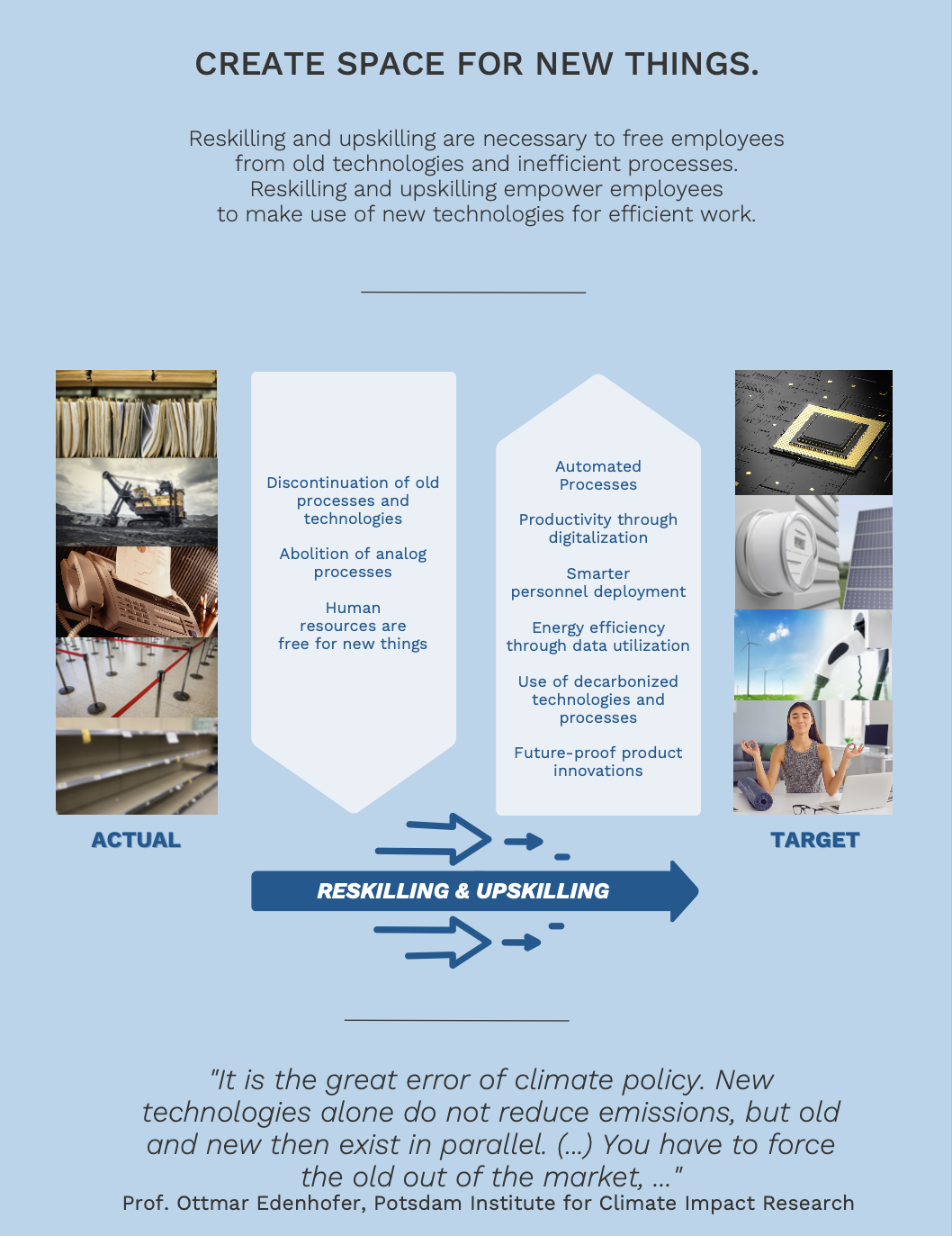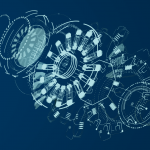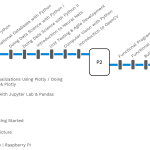Expert opinions and best practice examples
Sustainability is part of our DNA”, “We use green electricity in our offices”, “Our company cars are now powered by electricity” – ever read one of these phrases on a company website or in a LinkedIn post? Due to the advancing climate crisis, phrases like these are no longer enough for companies: The economically challenging last few years as well as increasing consumer expectations regarding sustainability are forcing companies to be digital and sustainable at the same time in order to remain fit for the future. Are these two requirements mutually exclusive or do they even complement each other?
We have already visualized decarbonization in the overall context of the current challenges in an infographic. In this article, we highlight the concrete connection between sustainability and digitalization.
,,The basic idea of digitalization and automation is the optimization of an existing process. (…) And if we look at efficiency and optimization, then the basic idea of digitalization is also a sustainable transformation. Because then I’m faster, need less manpower, and of course, consume less energy. Then I am de facto more sustainable.”
Sascha Pallenberg
This assumption, which Sascha Pallenberg made in a podcast discussion for Digital4Leaders, can be taken even further: Not only does digitalization go hand in hand with sustainability, but sustainability, conversely, only succeeds through digitalization. The increasing interconnectedness of all areas of life increases energy and resource efficiency and optimizes processes. In connection with decarbonization, the question arises: How do we get out of analog processes and environmentally harmful procedures in order to do business sustainably?
Create space for new things
This can only succeed by creating space for new things. Because there is currently not enough room for automated processes, digital tools, efficient personnel deployment, decarbonized processes, and product innovations. Because the old still exists, the opportunities for innovation are limited – both in terms of products and processes and the associated activities of employees. Making room for the new means discontinuing old technologies and eliminating analog processes to free up human resources. However, these people do not lose their jobs as a result; on the contrary, companies now have the opportunity to reskill and upskill their employees. This enables them to work efficiently with new technologies to develop solutions for the challenges of our time.
But how?
One example of what companies can do with these free resources is to shift their mindset to the concept of the circular economy. Dr. Manuel Braun explained this in more detail in an episode of Digital4Leaders Jan Veira.
What is the circular economy? The idea of a circular economy has always existed. This is because it is based on nature's processes, where no waste is produced and aims to decouple economic growth from resource consumption. A circular economy thus means an economic system that uses resources as efficiently as possible. Above all, product design and product usage play a central role in this. Products should have the following characteristics: - durable - reusable - recyclable
According to Dr. Braun, the circular economy is not only a way of operating more sustainably and facing up as a company to its responsibility in the fight against the climate crisis but also offers a real competitive advantage:
Now that supply chains are so extremely disrupted, it may no longer be just a matter of creating value by selling as many products as possible, but also over the lifetime of a product. If, for example, as a company, I consider that I no longer sell a product, but instead retain ownership and only offer the service, then on the one hand I can build long-term customer relationships, and on the other hand, I have incentives – for example, to design a product so that it functions over the long term so that it can be repaired, for example via remote maintenance. And we see that companies that think ambitiously about the circular economy have a real competitive advantage. This is demonstrated by (…) examples such as Patagonia, CWS, Philipps, Trumpf, etc.
Manuel Braun
The circular economy approach also offers significant benefits for the economy as a whole: The European Commission estimates that consistent implementation of the Circular Economy Action Plan in the EU can contribute 0.5% growth to GDP by 2030 and create up to 700,000 new jobs.
Sustainability needs digitalization – an example from the real estate market
The real estate sector shows why digitalization is indispensable for the implementation of sustainability. Here, the digitalization and standardization of data such as energy consumption, carbon footprint, or waste collection offer investors the opportunity to actively and efficiently drive the sustainability of their real estate and actually achieve ESG goals. Jens Müller talked about this in detail with Jan Veira in the podcast and noted the following, among other things:
What do we have to do to improve the carbon footprint, to get the footprint down? Buildings account for 40 percent of this because we live in them and produce in them. You can look at transportation, cars, airplanes, etc: In total, buildings are the biggest CO2 emission source we have. (…) We have to be able to change the substance in the building. In a relatively short time. Because most companies have promised to run their portfolios CO2-neutral in the years 2040 to 2050. (…) We have a very complex optimization task ahead of us, which has to be done digitally because there is no other way to scale it.
Jens Müller
Jens Müller cites the creation of a digital twin in the form of an asset portfolio for buildings as a concrete solution for the standardization and digitalization of real estate projects. The advantage:
I see an operational carbon footprint and the energy balance of my entire portfolio. I can use it to dynamically do my planning and de facto have a value generation of the portfolio via the platform. (…) For example, a collection app for waste: The workflow is set up on the platform, and the employees are told what needs to be done. This is set up once and can then be scaled up. What is not standardized and digitalized does not scale.
Jens Müller
Levers for digitalization and sustainability: reskilling and upskilling
Digitalization and sustainability can only be driven by digital tools, product innovations, new technologies, processes, and procedures. In order to understand these and use them skilfully, employees need new skills that enable companies to increase productivity and respond to market requirements in an agile manner. Company-specific reskilling and upskilling accompanying work are therefore important levers for enabling digitalization and sustainability.



